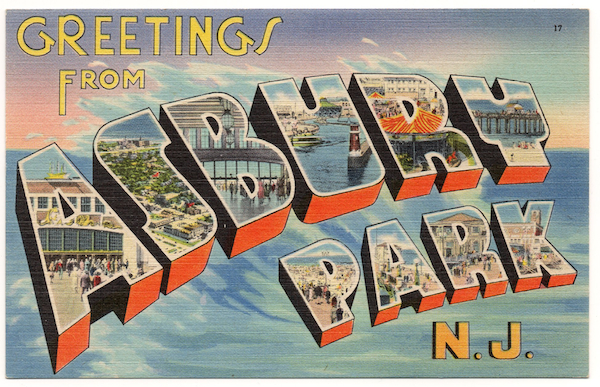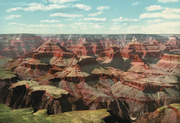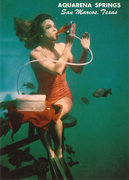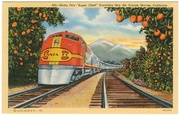From the 1930s through the 1950s, tourists taking their first road trips in their newfangled automobiles would frequently stop along the way to pick up a few colorful postcards to mail to the folks back home. The most popular form of eat-your-heart-out greeting was the large-letter postcard, which had been around since the first part of the 20th century but whose heyday was during what we know today as the linen-postcard era. Made of textured paper rather than actual cloth, linen postcards were printed by companies such as Curt Teich & Company of Chicago, Tichnor Brothers and Colourpicture of Boston, E.C. Kropp of Milwaukee, Beals Litho & Printing of Des Moines, and Dexter Press of Pearl River, New York, among many others. Their souvenir postcards for states, cities, military bases, and tourist attractions were usually heralded at the top by the words “Greetings From,” below which were large, blocky, dimensional letters filled in with illustrations or photographs of the destination’s most scenic or noteworthy sights.
Since 2009, the primary resource for fans of this popular postcard genre has been “Large Letter Postcards: The Definitive Guide, 1930s to 1950s,” written by Fred Tenney and Kevin Hilbert. Published by Schiffer, “Large Letter Postcards” features more than 2,200 examples, from several dozen versions of Atlantic City cards (Curt Teich’s first linen large-letter) to cards for Coney Island, Niagara Falls, and Death Valley. Also included are several examples of how large-letter postcards were created, from the card’s initial sketch to its final design, courtesy of materials loaned to the authors by the Curt Teich Postcard Archives.

Though published by Stanley A. Piltz of San Francisco, the stock number of this large-letter postcard (seen at lower right) identifies it as a Curt Teich card, printed in 1938.
While Tenney freely admits that he got into large-letters because he noticed there were a lot of them available for a dime when he was sure he could sell them for a buck, Hilbert is a serious collector, owning, by his estimation, some 6,000 to 7,000 postcards of various types, including the duplicates.
Related: A Brief History of the Postcard
“When I first started out,” Hilbert says, “I wanted to get all the Arizona ones.” That’s how most collectors begin, accumulating cards from their hometown or state (Hilbert lives in Tempe, Arizona). “Then I wanted to get one from each state,” he continues, “then I decided I wanted to get all the Curt Teich large-letters.” That put him on a course to collect the more than 1,000 linen large-letter postcards printed by Curt Teich. Hilbert eventually branched out to Tichnors and cards by other printers, as well as more arcane classes of large-letter postcards, from “folders” (an accordion-folded sheet, whose images on the postcards that make up each sheet can often be matched to the views within each of the large letters on a sheet’s cover) to minis (postcards that are only about 2 1/2 inches tall by 3 1/2 inches wide).

Curt Teich printed exactly one card for the state of Alaska. According to postcard lore, the 1942 cards were not good sellers, and so the retailer who ended up with boxes of them eventually threw them in a dumpster, creating instant scarcity.
Curt Teich is in a class all its own, employing three distinct printing techniques—the five-color Colortones, which account for 90 percent of all Curt Teich large-letter postcards; four-color American Art cards printed from 1940 to 1955; and the five-color Photo-Colorit process, which was used on only five deckled-edge postcards printed between 1938 and 1948. To date a Teich postcard, look for the number and letter preceding the card’s stock number on the lower-front of the card or running vertically in the center of its back. An “A” identifies cards printed in the 1930s, “B” is for the 1940s, and “C” denotes the 1950s, which means that a cards beginning with “8A” was printed in 1938, “5B” in 1945, “0C” in 1950, and so on.
Since its publication, Tenney and Hilbert’s book has become a must-have among postcard dealers and collectors alike, although sharing so much factual information about large-letter postcards with the rest of the collecting world has had its drawbacks. Gone, for example, are the days when Tenney could pick up large-letter postcards for a dime, and these days when Hilbert buys cards by the lot, as he still occasionally does, the chances that it’ll contain a rare gem are low. “Back before the book,” Hilbert says with a soft sigh, “it was easier to find that kind of stuff.”
(All photos via Kevin Hilbert and Large Letter Postcard Site. If you buy something through a link in this article, Collectors Weekly may get a share of the sale. Learn more.)

























 The Real Mermaids of San Marcos, Texas
The Real Mermaids of San Marcos, Texas
 In Living Color: The Forgotten 19th-Century Photo Technology that Romanticized America
In Living Color: The Forgotten 19th-Century Photo Technology that Romanticized America The Real Mermaids of San Marcos, Texas
The Real Mermaids of San Marcos, Texas How Linen Postcards Transformed the Depression Era Into a Hyperreal Dreamland
How Linen Postcards Transformed the Depression Era Into a Hyperreal Dreamland Large Letter PostcardsThe heyday of large-letter postcards was the 1930s through the 1950s, which…
Large Letter PostcardsThe heyday of large-letter postcards was the 1930s through the 1950s, which… Linen PostcardsLinen postcards were printed in the United States from the 1930s until the …
Linen PostcardsLinen postcards were printed in the United States from the 1930s until the … PostcardsPostcards, sometimes spelled out in two words as "post cards," emerged duri…
PostcardsPostcards, sometimes spelled out in two words as "post cards," emerged duri… Mari Tepper: Laying it on the Line
Mari Tepper: Laying it on the Line Nice Ice: Valerie Hammond on the Genteel Charm of Vintage Canadian Costume Jewelry
Nice Ice: Valerie Hammond on the Genteel Charm of Vintage Canadian Costume Jewelry How Jim Heimann Got Crazy for California Architecture
How Jim Heimann Got Crazy for California Architecture Modernist Man: Jock Peters May Be the Most Influential Architect You've Never Heard Of
Modernist Man: Jock Peters May Be the Most Influential Architect You've Never Heard Of Meet Cute: Were Kokeshi Dolls the Models for Hello Kitty, Pokemon, and Be@rbrick?
Meet Cute: Were Kokeshi Dolls the Models for Hello Kitty, Pokemon, and Be@rbrick? When the King of Comedy Posters Set His Surreal Sights on the World of Rock 'n' Roll
When the King of Comedy Posters Set His Surreal Sights on the World of Rock 'n' Roll How One Artist Makes New Art From Old Coloring Books and Found Photos
How One Artist Makes New Art From Old Coloring Books and Found Photos Say Cheese! How Bad Photography Has Changed Our Definition of Good Pictures
Say Cheese! How Bad Photography Has Changed Our Definition of Good Pictures Middle Earthenware: One Family's Quest to Reclaim Its Place in British Pottery History
Middle Earthenware: One Family's Quest to Reclaim Its Place in British Pottery History Fancy Fowl: How an Evil Sea Captain and a Beloved Queen Made the World Crave KFC
Fancy Fowl: How an Evil Sea Captain and a Beloved Queen Made the World Crave KFC
Great article! I think the unique, canvas-like texture adds to the appeal as well. It was developed specifically to accommodate the new inks that came available at that time. And fortunately that time coincided with the building of Boulder/Hoover dam, which are the ones I collect!
My Dad and uncles were the owners of Colourpicture Publishers of Boston. So proud to see their postcards ( Plasticrome greetings made by Colourpicture) mentioned in this article